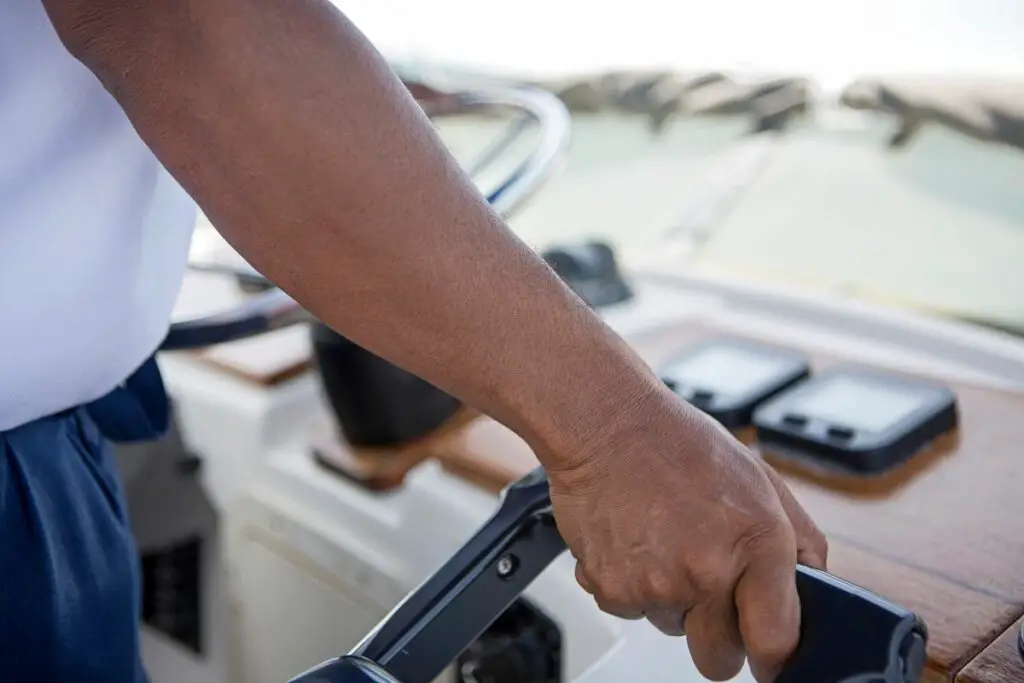If you are operating or traveling on a power boat, you will probably notice a switch which has a lanyard attached to it. This is called the ignition safety switch, or the engine cut off switch. It is an important part of the boat controls.
But why is there a lanyard attached to it? And what does an ignition safety switch do? Keep reading to find out.
What Is An Ignition Safety Switch?
An ignition safety switch, also known as an engine cut off switch or ECOS, is an important safety feature of power boats. It controls the engine, switching it on or off. There is a lanyard attached to the switch.
Why Do Ignition Safety Switches Have Lanyards?
The lanyard attached to the ignition safety switch is also attracted to the life vest or wrist of the person operating the boat. This means that if the boat operator falls in the water or is thrown overboard, the engine will immediately cut out.
Stopping the engine as soon as the operator goes overboard has several uses. It stops the boat from continuing forward, which keeps the passengers on the boat safer.
If the boat is speeding off and nobody knows how to stop it or steer it then there is a high risk of a crash or an accident. The boat could crash into another boat, a rock, a bank, or something else.
It could also capsize if it is not being steered and navigated correctly. If the engine cuts out then the boat will remain close to the person who has fallen overboard.
This means that they have a much better chance of being reunited with the vessel, preventing the need for them to be rescued and getting them out of the water to safety.
Another important benefit of cutting the engine off immediately is that it significantly reduces the risk of injuries caused by the propellers, as well as other types of injuries.
A 3 blade propellor running at speed of 3200 rotations per minute can deliver 160 impacts per second. This is why every second counts when it comes to turning off the engine when someone is in the water nearby.
Not only will it protect the person in the water, it will also prevent your boat from getting damaged.
Self-Circling
Some power boats have a self-circling feature. This means that when the operator is thrown overboard, the boat will slow down as the engine idles and the boat will travel in circles.
This is designed to make it easier for the operator to return to the boat, even if they were the only passenger.
If your boat has this feature, then you need to make sure that the idle speed is very low.
If the speed is too high and the boat is circling, the person in the water is at great risk of sustaining a serious injury from one of the propellers and it will be very difficult to get back on board the boat.
Do You Need An Ignition Safety Switch?

Ignition cut of switches are not required on all power boats by federal law, but most state laws require the operator of a power boat to use an ignition safety switch with a lanyard at all times.
If you are in a state where it is not required by law, you should still consider using the lanyard as it is intended. If something happens, it could prevent loss of life or injury.
If you have a boat that is less than 26 feet in length and has a horsepower of 3 or more, then it is federal law to clip the lanyard on the ignition safety switch to your life vest or clothing.
What If Your Boat Doesn’t Have An Ignition Safety Switch?
There are some older models of boat that do not have an ignition safety switch. If this is the case, you should arrange to have one installed as soon as possible.
When buying a second hand boat, this is something that you need to consider – you will need to pay to install an ignition safety switch on top of the cost of the boat.
If you have an older boat that falls within the above description and an ignition switch is required to be used by federal law, then it is the responsibility of the boat owner to install and maintain the ignition switch.
If you are caught using a boat that does not have one then you will not be able to argue that there was no ignition switch installed when you bought the boat.
Do You Need To Wear The Lanyard All The Time?
There are times when it is not necessary to wear the lanyard. If the engine is in idle then you don’t need to have the lanyard clipped to your clothing or life vest.
However, if you do not need to move around the boat then you might as well use it just in case.
When you are docking the boat you don’t need to have the lanyard clipped to you. You will often be more mobile when docking the boat, so it is not always practical to use the lanyard at this time.
When you are leaving the dock, it is best to attach the lanyard before you pull away. It is easier to do it before you pick up speed, and it prevents you from forgetting to do it later on.
If your boat is over 26 feet long then you are not required to have an ignition safety switch with a lanyard. You also don’t need one by law if the main helm of the boat is enclosed in a cabin.
This is because the person operating the boat won’t be able to fall in the water while they are driving.
Summary
The lanyard attached to an ignition safety switch attaches to the clothing of the person operating the boat. If the boat operator is thrown overboard then the engine will immediately cut off, which prevents serious injury and possible loss of life.

